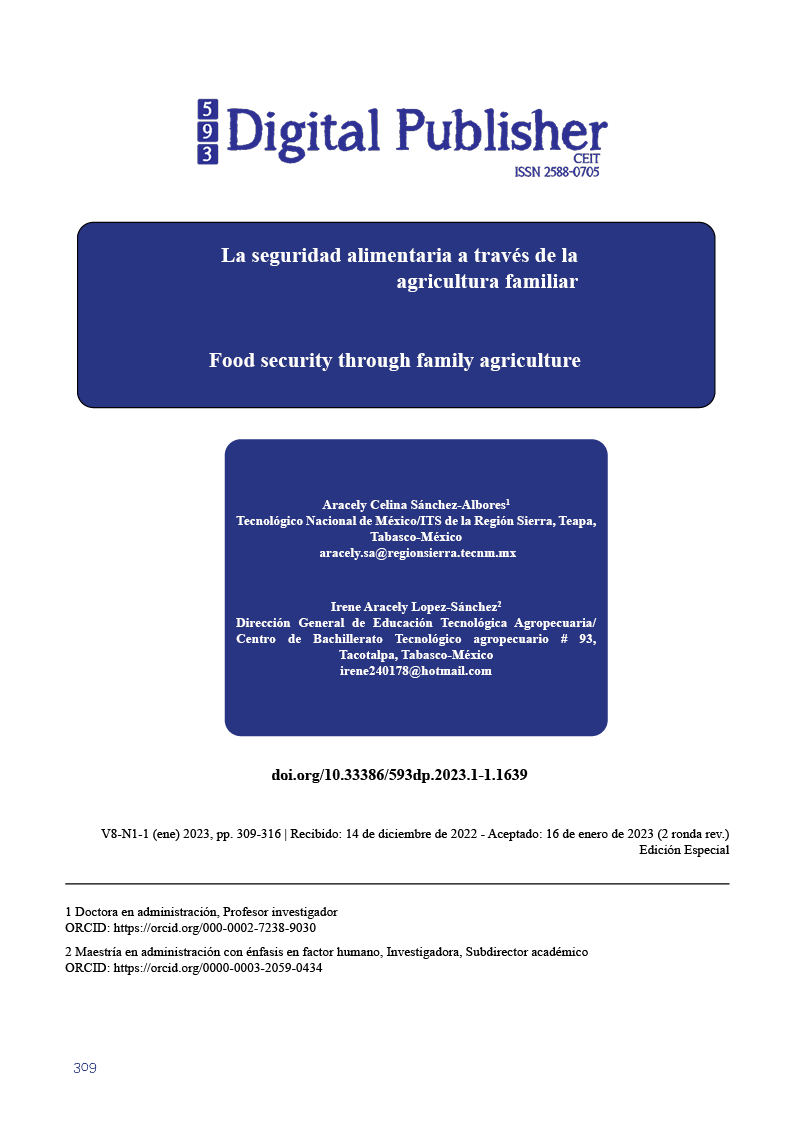Food security through family farming
Main Article Content
Abstract
The present study described the problem of the use of the cultivation of fruits of family farming in the town of Mina and Matamoros (San Pablo Tamborel) in the municipality of Teapa, Tabasco, the methodology used was based on a descriptive-analytical study with a mixed approach in the 14 agricultural producers participated, corresponding to 25%, of which 80% were male and 20% female, with a confidence level of 95% and a margin of error of 22.89%. A structured questionnaire was applied in four sections with 100 items validated by experts in the area. In conclusion, the fruit production of the mentioned locality showed a productive behavior of a smaller scale, due to important factors among them the agronomic management of fruit trees before and during production, the result that was obtained in relation to this problem is due to the fact that 8 % fertilize, 12% prune, 30% use traditional techniques, 10% control pests and diseases and 40% none and regarding the use of fruits as part of food security 56.52% is for self-consumption, 10% feed for farmyard animals , 10% homemade industrialization and 23.48% sell it at a very low price and in a very competitive market, in the same way the contribution of women to agricultural production is essential, since it represents 43% of the labor force in the sector in developing countries Salazar and Muños (2019), in addition, the participation of women in fruit agriculture in the studied locality is 62.57%.
Keywords: food security, fruit production, use of fruits
Downloads
Article Details

This work is licensed under a Creative Commons Attribution-NonCommercial-ShareAlike 4.0 International License.
1. Derechos de autor
Las obras que se publican en 593 Digital Publisher CEIT están sujetas a los siguientes términos:
1.1. 593 Digital Publisher CEIT, conserva los derechos patrimoniales (copyright) de las obras publicadas, favorece y permite la reutilización de las mismas bajo la licencia Licencia Creative Commons 4.0 de Reconocimiento-NoComercial-CompartirIgual 4.0, por lo cual se pueden copiar, usar, difundir, transmitir y exponer públicamente, siempre que:
1.1.a. Se cite la autoría y fuente original de su publicación (revista, editorial, URL).
1.1.b. No se usen para fines comerciales u onerosos.
1.1.c. Se mencione la existencia y especificaciones de esta licencia de uso.
References
Águila-Ayala, A., Martínez-Tuero, Y., Marcelo-García, L. (2021). Agricultura familiar: un paso necesario hacia el logro de la seguridad alimentaria mundial. Revista Márgenes, 9(1), 91-104. Recuperado de http://revistas.uniss.edu.cu/index.php/margenes/issue/ view/1180.
Castillo, E. (2017). Agricultura familiar y seguridad alimentaria en el ejido San Sebastián Yaxché, Peto, Yucatán. En M. A. Sámano y J. Baca del Moral (Coords.), Agricultura multifuncional y políticas públicas en México. Chapingo: Universidad Autónoma de Chapingo.
Chapela, G. y Menéndez, C. (2014). México: políticas para la agricultura campesina y familiar. Un marco de referencia. En E. Sabourin, M. Samper y O. Sotomayor (Coords.), Políticas públicas y agriculturas familiares en América Latina y el Caribe. Balance, desafíos y perspectivas. Chile: CEPAL-IICA-CIRAD-Red de políticas públicas y desarrollo rural en América Latina- Cooperación Regional Francesa para América del Sur.
FAO (2020). United Nations decade of family farming 2019-2028. Global Action Plan. Recuperado de http://www.fao.org/family-farming/detail/en/c/1195619/.
FAO y OPS (2017). Panorama de la Seguridad Alimentaria y Nutricional en América Latina y el Caribe. Santiago de Chile, Chile.
Graeub, B., Chappell, J., Wittman, H., Lederman, S., Bezner Kerr, R., y Gemmill-Herren, B. (2016). The State of Family Farms in the World. World Develompment, 87, 1-15. doi https://doi.org/10.1016/j.worlddev.2015.05.012.
Hernández, R., Fernández, C. y Baptista, P. (2003). Metodología de la investigación (3ª ed.). México: Editorial Mc Graw-Hill..
Hurtado de Barrera, Jacqueline (2006). El proyecto de Investigación. Caracas: Editorial Sypal.
Interian, C., Jiménez, J., Harry, F. y Dzib, M. (2017). La agricultura familiar y su relación con la seguridad alimentaria: caso de la comunidad de Pozo Pirata, José María Morelos, Quintana Roo. En M: A. Sámano y J. Baca del Moral (Coords.), Agricultura multifuncional y políticas públicas en México. Universidad Autónoma de Chapingo.
Jiménez, O., Ruenes, M., & Montañez, P. (1999). Agrobiodiversidad de los solares de la península de Yucatán. Gestión de Recursos Naturales.
Lina Salazar y Gonzalo Muñoz(2019).Seguridad alimentaria en América Latina y el Carive. https://publications.iadb.org/es/seguridad-alimentaria-en-america-latina-y-el-caribe http://dx.doi.org/10.18235/0001784.
Macías, A. (2013). Los pequeños productores agrícolas en México. Carta Económica Regional, (111-112), 7-18. Recuperado de http://cartaeconomicaregional.cucea.udg. mx/index.php/CER/article/view/5490/5042.
Moyano, E. (2014). Agricultura familiar. Algunas reflexiones para un debate necesario. Economía Agraria y Recursos Naturales, 14(1), 133-140. Recuperado de https://ageconsearch.umn.edu/record/180114/files/7Tribuna.pdf.
Njuki, J.; Parkins, J.R; Kaler, Amy (Eds.) (2016): Transforming Gender and Food Security in the Global South.
Pérez Méndez, G. (2001). Modelos de investigación cualitativa en educación social. Madrid: Narcea,S.A.
Piza, C., Palacios-Díaz, L., Pulido, N. y Dallos-Rincón, R. (2016). Agricultura familiar: una alternativa para la seguridad alimentaria. Conexión Agropecuaria, 6(1), 13-25. Recuperado de http://www.scielo.org.mx/pdf/estsoc/v20n39/v20n39a6.pdf.
Samper, M. (2020). Contribuciones de los agroecosistemas campesinos y sistemas territoriales de agricultura familiar al desarrollo de los territorios rurales y a la seguridad alimentaria: conceptos medulares y cuestiones actuales. Enfoque rural, 1(1), 58- 80. Recuperado de https://enfoquerural.uaemex.mx/article/view/15472.
Tamayo y Tamayo, M. (2004). El proceso de la investigación científica, 4º ed.México: Limusa.
Yúnez, A., Cisneros, A. y Meza, P. (2013). Situando a la agricultura familiar en México. Principales características y tipología. Serie Documentos de Trabajo N°149. Grupo de Trabajo: Desarrollo con Cohesión Territorial. Programa Cohesión Territorial para el Desarrollo. Santiago de Chile: Rimisp. Recuperado de http://portalsiget.net/ ArchivosSIGET/recursos/Archivos/1682015_AgriculturaFamiliarM



